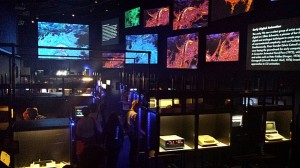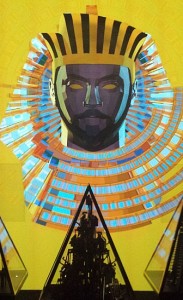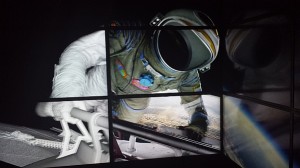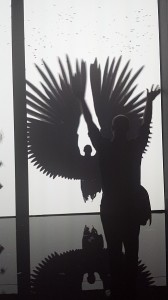 The Barbican is one of London’s architectural treasures, a modern-day brutalist fortress whose concrete facades and communal recreation areas would fit comfortably in utopian/dystopian genre fiction. The arts centre hosted there has a well-established history of confronting a number of important (and often fringe) cultural subjects amongst its extensive programming, and there are few places better suited in London to host a Digital Revolution. It’s an exhibition you absolutely must experience in its remaining two weeks before closing.
The Barbican is one of London’s architectural treasures, a modern-day brutalist fortress whose concrete facades and communal recreation areas would fit comfortably in utopian/dystopian genre fiction. The arts centre hosted there has a well-established history of confronting a number of important (and often fringe) cultural subjects amongst its extensive programming, and there are few places better suited in London to host a Digital Revolution. It’s an exhibition you absolutely must experience in its remaining two weeks before closing.
The stark and imposing setting perfectly frames an exhibition that begins in the 1970s with an exploration of the early days of computer technology and entertainment. Being a dedicated gamer myself, it was a delight to actually play an original Pong arcade machine for the first time. The trip down memory lane through numerous computer and console systems that I have fond memories of was a nice opening to a rather eclectic (and, at times, haphazard) exhibition that aimed to display a wide variety of digital experiences.
 This historical primer was really there to set the scene for the stars of the show, the interactive pieces of digital art and design that were attempting to display the cutting-edge of our cultural relationship with technology. A multi-screen display of the many different layers that make up a blockbuster film such as Gravity was followed by a psychedelic EDM experience that holographically projected the larger-than-ever ego of will.i.am in a cacophony of sound and colour elevating the man himself into techno-demigod status. These lead ups served as an introduction to the key element of the exhibition, which blurred the line between exhibitor and audience – allowing the exhibits to become part of our own creative and unique expression of body and identity.
This historical primer was really there to set the scene for the stars of the show, the interactive pieces of digital art and design that were attempting to display the cutting-edge of our cultural relationship with technology. A multi-screen display of the many different layers that make up a blockbuster film such as Gravity was followed by a psychedelic EDM experience that holographically projected the larger-than-ever ego of will.i.am in a cacophony of sound and colour elevating the man himself into techno-demigod status. These lead ups served as an introduction to the key element of the exhibition, which blurred the line between exhibitor and audience – allowing the exhibits to become part of our own creative and unique expression of body and identity.
We have always had a symbiotic relationship with our technology since the first tools were created from shards of rock, but now we are able to project this relationship outwards – to go beyond the previous confines of physical existence and begin to explore our collective imaginative space in a manner that is increasingly dynamic and immediately malleable. The interactive nature of the numerous installations displayed this new relationship with knowledge and art clearly and often in spectacular fashion, bringing a sense of wonder and play into the space of cultural expression. The interactive exhibits subverting spaces that are traditionally relegated to the realms of didactic learning and object fetishism.
The curatorial team should be strongly commended for pushing many boundaries of what an exhibition can be (even if only incrementally at times). The piece-de-resistance of this experiment being the truly immersive and enchanting Assemblance from Umbrellium that brings a sense of collaborative exploration of light and software which likely couldn’t be achieved so tightly just a decade ago. Overall the displays showed a wide variety of concept and design, and most of them were joyful to interact with. At least, that was certainly the case when you could get them to work properly.
 This is an exhibition that achieves what it sets out to do – to immerse you in the idea that our relationship to technology is opening up new and boundless areas of human creative experience. Yet, despite all the wonder one still can’t escape the often quaint and restricted idea of what the future holds that emerges from artists who grew up before the technology itself had come about. This brings with it a kind of cognitive dissonance, a detachment from the immersion that belies the transitional period we are in.
This is an exhibition that achieves what it sets out to do – to immerse you in the idea that our relationship to technology is opening up new and boundless areas of human creative experience. Yet, despite all the wonder one still can’t escape the often quaint and restricted idea of what the future holds that emerges from artists who grew up before the technology itself had come about. This brings with it a kind of cognitive dissonance, a detachment from the immersion that belies the transitional period we are in.
The final impression is less a revolution highlighting the new digital age as it is a swan-song that pays final tribute to old-fashioned modes of thinking. A juxtaposition between old and new that still feels tethered to where it has come from rather than where it might be going, with the artists’ vision throughout suffering from the constraints of the technology used to realise it. A number of interactive exhibits were ‘out of order’ or only semi-functional, and others felt clunky and less intuitive than they should have been. The ‘man behind the curtain’ easily discovered with just a step or two outside of the motion sensors, drawing you into experiences that often felt less like rising out of the ashes as a technological phoenix and more like a clipped bird that only had the use of one wing to try and fly out of its nest.
None of this is really at the fault of the artists, curators or exhibitors who put together this excellent and timely experience. Rather it is an artefact of the liminal space we find ourselves in – one in which digital media is only in its infancy despite all of our desires to see it as a fully formed and mature medium.
Our vision of the future is dictated to us by the dreams of the past, and at present these are firmly linked to an understanding of technology that predates the beginnings of our newfound digital capacity. Although the creators of these pieces were all certainly ‘pushing the boundaries of their fields’ there were few examples where new fields of expression were being created and the old modes torn down.
 Ultimately one was left with more of a sense of digital iteration over revolution. An astonishing overview of just how far we have come in such a short time, but nonetheless a feeling that we’re not quite ready to realise what happens next. We are not yet – at least not in such a public setting – capable of producing a seamless experience integrating our sense of physical and emotional being with our capacity for digital expression. We can articulate that it is only a small step away before we take the giant leap into an unbounded future, and yet the old modes of thinking still rule our creative expression.
Ultimately one was left with more of a sense of digital iteration over revolution. An astonishing overview of just how far we have come in such a short time, but nonetheless a feeling that we’re not quite ready to realise what happens next. We are not yet – at least not in such a public setting – capable of producing a seamless experience integrating our sense of physical and emotional being with our capacity for digital expression. We can articulate that it is only a small step away before we take the giant leap into an unbounded future, and yet the old modes of thinking still rule our creative expression.
What we are shown through this fantastic exhibition is more the culmination of what has come before rather than a true vision of the revolutionary space that the future will bring. The revolution of a digital future has yet to come, but engaging experiences such as this are clear evidence that we’re getting very good at saying goodbye to our non-digital past.
[I would like to give a special thanks to the curators of the exhibition for openly encouraging photography!]




